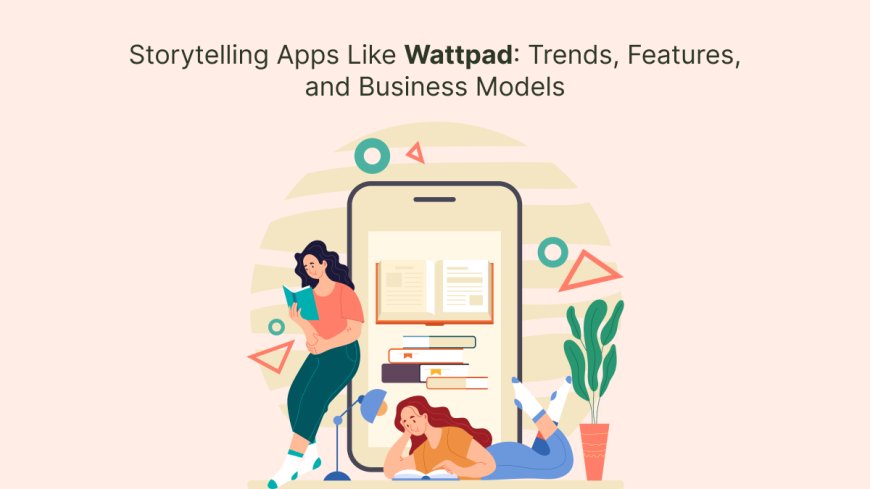Storytelling Apps Like Wattpad: Trends, Features, and Business Models
Explore the latest trends, essential features, and business models for storytelling apps like Wattpad. Learn how to build a scalable, profitable platform for writers and readers.

The digital storytelling landscape is evolving fast. With more users consuming stories on mobile devices, storytellingapps like Wattpad have paved the way for a new era of content creation and distribution. For businesses looking to enter this growing market, understanding emerging trends, essential features, and profitable business models is critical.
Lets explore how the industry is shifting and what it takes to build a successful storytelling platform that attracts both writers and readers.
Current Trends Shaping the Storytelling App Market
The rise of user-generated content has transformed storytelling apps into dynamic social ecosystems. Several key trends are driving this evolution. AI-powered content recommendations are now becoming standard, allowing users to discover stories that match their reading history and personal preferences. Microtransaction models, such as pay-per-chapter unlocking, are gaining momentum as readers show a growing willingness to pay for serialized, episodic content. A mobile-first experience is no longer optional; with most users accessing storytelling platforms via smartphones and tablets, seamless mobile functionality is essential. Community engagement tools like reader polls, live chats, and writing contests are playing a major role in retaining users and encouraging ongoing participation. Additionally, niche storytelling platforms that focus on specific genres or demographics are successfully capturing dedicated audiences outside of mainstream apps. These trends clearly reflect the rising demand for personalized, engaging, and revenue-generating storytelling environments.
Must-Have Features for Storytelling Apps
To compete with established players like Wattpad, your platform must deliver features that balance user engagement with monetization.
Reader-Centric Features
- Personalized content feeds based on past reading behavior
- Advanced search filters for genres, story length, popularity, and language
- Offline reading modes for uninterrupted access
- Interactive commenting at chapter or story level
- Reading customization tools, allowing users to adjust themes, fonts, and layouts
Writer-Centric Features
In-app publishing tools empower writers to draft, format, and schedule their stories with ease. Performance analytics help track views, engagement, and earnings. Flexible monetization options like pay-per-chapter and tipping give writers control over revenue. Community management and story promotion features further help authors grow their audience and boost visibility.
Admin and Moderation Tools
Robust admin features are essential for managing both user experience and platform operations. Content moderation tools help filter spam, inappropriate material, and address user-reported issues, ensuring a safe and engaging environment for all users. Effective user management systems allow administrators to handle profiles, permissions, and other account-related tasks efficiently. In-app analytics provide valuable insights into platform performance, user engagement, and revenue trends, helping business owners make informed decisions. Push notification controls enable targeted communication, ensuring users receive timely updates without being overwhelmed. Additionally, flexible ad management tools allow seamless integration and monitoring of in-app advertising campaigns, creating new revenue streams. By incorporating these features, you build a platform that meets both user expectations and business objectives.
Popular Business Models for Storytelling Platforms
- Selecting the right business model ensures your storytelling app remains profitable while offering value to both writers and readers.
- Subscription-based models provide readers with access to premium content, ad-free experiences, or early chapter releases for a monthly fee.
- Pay-per-chapter models encourage microtransactions, letting readers unlock specific chapters or stories as needed.
- In-app advertising remains a steady revenue stream, especially for free-to-use platforms with high engagement rates.
- Tipping and donation systems allow fans to directly support their favorite authors, increasing writer satisfaction.
- Brand partnerships and sponsored content give businesses the option to promote targeted messages within popular story feeds.
- Using a mix of these models diversifies your revenue streams and minimizes dependency on a single income source.
Read More: Best Wattpad Alternatives for Writers & Readers in 2025
Technology Stack for Developing a Storytelling App
- Building a feature-rich storytelling app requires choosing the right technology stack that ensures scalability and performance.
- Frontend frameworks like React Native or Flutter allow fast cross-platform mobile app development.
- Backend services using Node.js or Python offer scalable server-side logic and real-time data processing.
- Database solutions like MongoDB or PostgreSQL efficiently manage large volumes of user-generated content.
- Cloud hosting on platforms like AWS or Google Cloud ensures uptime, fast data access, and storage scalability.
- Content Delivery Networks (CDNs) help deliver stories faster to users across different regions.
- A strong technical foundation supports user growth and content expansion without performance bottlenecks.
Marketing Strategies for Storytelling Apps
- Attracting both writers and readers requires targeted marketing efforts that build visibility and trust.
- Leverage social media marketing to reach writing communities and avid readers across platforms like Instagram, Twitter, and TikTok.
- Offer writer incentive programs such as publishing contests, higher revenue share percentages, or special promotions for early adopters.
- Use SEO and content marketing to attract organic traffic from users searching for storytelling apps or alternatives to Wattpad.
- Run influencer collaborations with popular authors or book bloggers to build credibility and attract followers.
- Optimize your apps presence on Google Play and the App Store through App Store Optimization (ASO) strategies.
- Consistent marketing ensures sustained growth and long-term engagement.
Scaling and Retaining Users
- User acquisition is only the first step. Long-term success depends on retaining users and growing engagement.
- Regularly introduce new app features based on user feedback.
- Run seasonal campaigns, reading challenges, or writing contests to boost participation.
- Offer personalized notifications to remind users about new chapters, recommended stories, or community events.
- Implement loyalty programs that reward active readers and writers with in-app perks or discounts.
- Monitor analytics to understand user behavior and make data-driven improvements.
- These retention strategies help maintain active user bases and encourage ongoing content creation.
Challenges to Expect in the Storytelling App Market
Storytelling apps face key challenges like scaling for growing user bases, moderating large volumes of content, retaining top writers, balancing monetization, and ensuring global data privacy compliance. Partnering with an experienced app development team helps address these issues effectively.
FAQs
What business models work best for storytelling apps?
Popular models include subscription plans, pay-per-chapter unlocking, in-app ads, and tipping systems for writers.
How important is mobile-first design for these platforms?
Extremely important. Most users access storytelling apps on mobile devices, making responsive and fast-loading mobile design essential.
Can startups compete with large platforms like Wattpad?
Yes, by focusing on niche genres, underserved markets, or offering better monetization and engagement tools, startups can capture dedicated user bases.
How do storytelling apps attract quality writers?
By offering strong monetization options, promotional tools, community engagement features, and data-driven performance insights.
Whats trending in storytelling app development for 2025?
AI-driven content discovery, gamified reading experiences, real-time reader-writer interactions, and multilingual content support are major trends.
Conclusion
For businesses exploring entry into the digital content space, building storytelling apps like Wattpad offers significant market and revenue potential. By partnering with a skilled on demand app development company, you can create a scalable, feature-rich platform that attracts writers, delights readers, and aligns with the fast-changing dynamics of the storytelling industry.
































